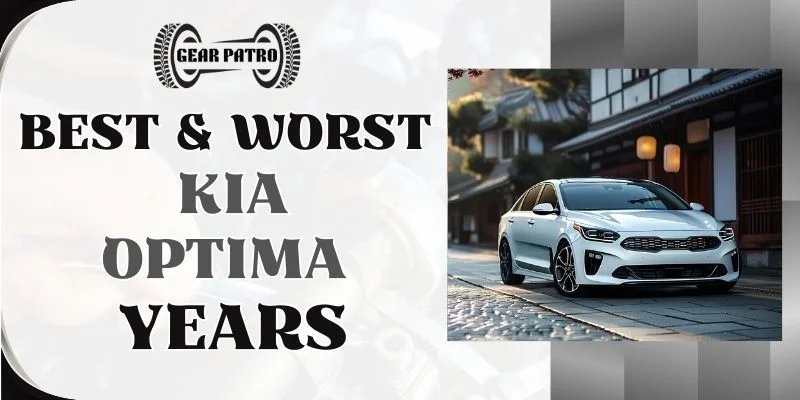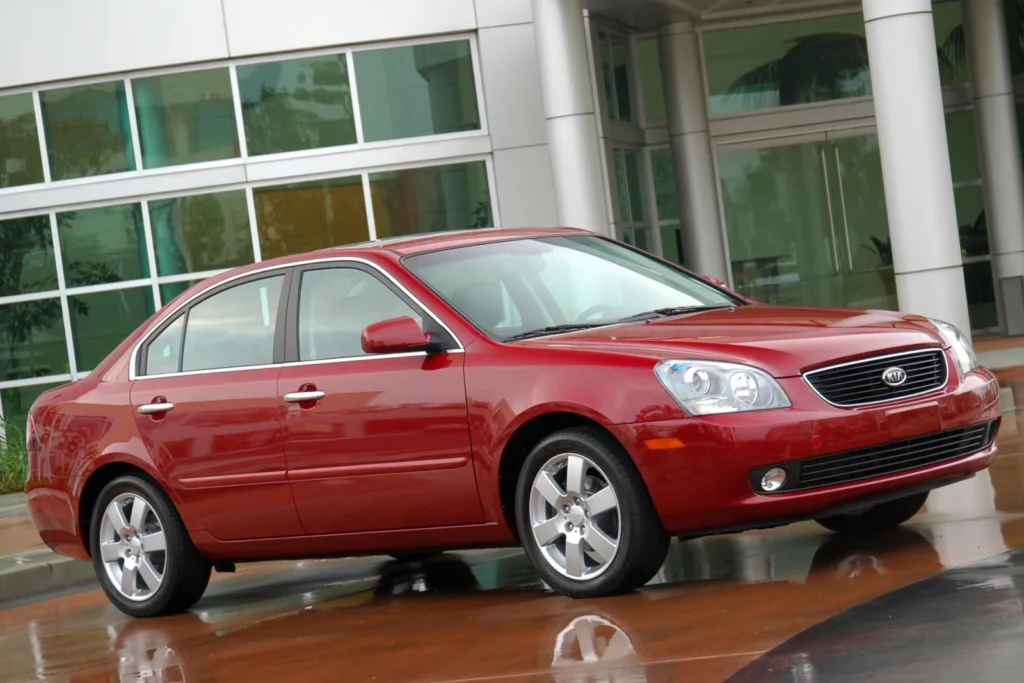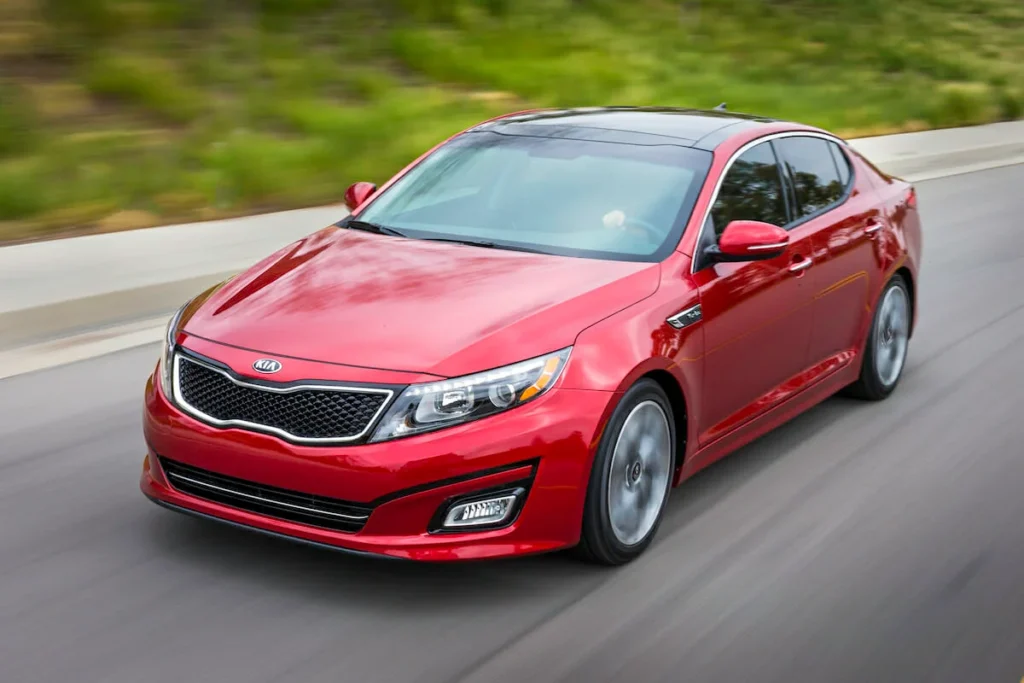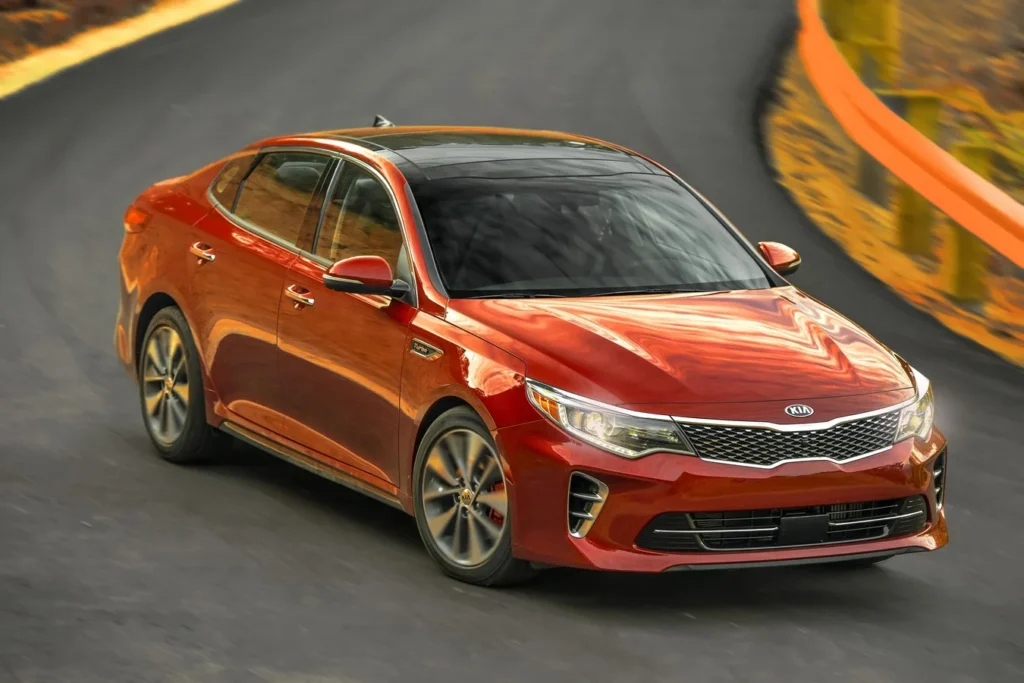To make it easy for you to pick the best Kia Optima, we have ranked all models for every generation.
Throughout this guide, I’ll show you which Kia Optima generations are best to buy and which are worst to stay away from.
As a result of our extensive, unbiased research, including data from NHTSA and JD Power as well as first hand owner reviews, we ensure that our Kia Optima review is comprehensive and unbiased.

Using this guide, you will discover why you should not buy a Kia Optima from 2011-2015, what the problems with Kia Optima are, and which Kia Optima year is most reliable.
It’s time to get started.
Kia Optima Generations
A sleek design coupled with smooth performance has been the hallmark of the Kia Optima since it was introduced in 2000.
The initial Optima models were offered with either 2.4L I4 or 2.7L V6 engines, ensuring a spirited performance along with safety features like side airbags and ABS, paving its future as a top midsize sedan.
This page provides an overview of the various generations of Kia Optimas between 2001 and 2020.
From 2021 onwards, the Kia K5 will replace the Kia Optima, which was discontinued in 2020.
| Generation | Years |
| 1st generation (MS) | 2001-2006 |
| 2nd generation (MG) | 2007-2010 |
| 3rd generation (TF) | 2011-2015 |
| 4th generation (JF) | 2016-2020 |
Particularly if you are considering buying a used Kia Optima, you should understand the different generations.
Kia Optima Best, Neutral, and Worst Years
There are a number of factors that go into our ranking and categorization of the best and worst Kia Optima years, including:
Below is a graph that combines scores from the various sources.
In order to categorize each model year, we create a structured table that categorizes it as the best, neutral, or worst year for the Kia Optima.
| Generation | Best Years | Neutral Years | Worst Years |
| 1st generation (MS) | 2005 2006 | 2003 2004 | 2001 2002 |
| 2nd generation (MG) | 2009 2010 | N/A | 2007 2008 |
| 3rd generation (TF) | 2015 | N/A | 2011 2012 2013 2014 |
| 4th generation (JF) | 2017 2018 2019 2020 | N/A | 2016 |
The term “Neutral Years” refers to models that don’t stand out nor falter significantly in aspects such as reliability and owner satisfaction, and are positioned between the top and bottom of Kia Optima’s range.
The number of complaints and recalls associated with our reliability score is inversely proportional with the number of NHTSA recalls.
We’ll take a look at the best, neutral, and worst years of the Kia Optima.
Best & Worst Years for Kia Optima 1st Generation (2001-2006)
In 2001, Kia introduced the Optima, whose first generation featured a blend of reasonable pricing and ample features. However, many mechanical or electrical problems plagued the original models.

In this generation, the Kia Optima years between 2005 and 2006 are the best, whereas those between 2001 and 2002 are the worst.
The Best Years: 2005, 2006
If you’re considering purchasing a first-generation Kia Optima in 2005 or 2006, your best options are the 2005 and 2006 models.
Kia Optima models from 2005 and 2006 featured more stable and refined engines, including the 2.4L Sirius II I4 and 2.7L Delta V6, providing decent mileage and a balanced performance.
In order to suit different driving styles, there were two transmission options available: a five-speed manual and a four or five-speed automatic.
Moreover, higher trim levels introduced ABS brakes and stability control, which improved the quality of interior materials.
Nevertheless, issues from the previous years remained a shadow. Occasionally, reports of engine problems cropped up, as well as complaints about malfunctioning power windows and door locks.
The Neutral Years: 2003, 2004
The best and worst Kia Optima years are 2003 and 2004 because of significant reliability issues.
These models are powered by 2.4L I4s which are somewhat reliable and 2.7L V6s which are slightly more powerful.
Consumers were able to choose between manual and automatic transmissions, with automatic being the most popular.
According to our tests, the vehicle has an average fuel economy of 21 city / 30 highway mpg, which is considered to be standard in its class.
A number of mechanical issues occurred during these years, such as unexpected engine stalls and premature transmission wear.
After several years of electrical issues, especially with the door locks and power windows, they were able to align them neutrally.
The Worst Years: 2001, 2002
There’s no doubt that 2001 and 2002 are the worst years to buy a Kia Optima.
A major criticism of the 2001 Kia Optima was its unreliable performance, despite providing a variety of driving options.
The number of complaints about transmission failures and engine stalling increased along with complaints about suspension corrosion and structural problems such as door locks that wouldn’t open or power windows that wouldn’t work.
There was a recall for the 2001 Kia Optima, which was plagued by a crankshaft position sensor defect.
Also, the 2002 Kia Optima suffered from the same problems.
Optima recalls and complaints from the NHTSA from 2001, 2002, 2003, 2004, 2005, 2006 can be found here.
Best & Worst Years for Kia Optima 2nd Generation (2007-2010)
In addition to providing more interior space and a smoother ride, the 2nd-gen Kia Optima had a wider stance and a longer wheelbase.

It’s best to avoid the 2007 and 2008 Kia Optima models of the generation, while 2009 and 2010 are the best years of the generation.
The Best Years: 2009, 2010
In the second generation of Kia Optima, 2009 and 2010 are the best years, with relatively fewer issues and high owner satisfaction.
The G4KC/G4KE I-4 produced 175 hp and the G6BA/G6EA V-6 produced 190 hp, with manual or automatic transmissions available.
In terms of fuel economy, the vehicle offers 22 city/32 highway mpg, which is a commendable offering for those who prioritize fuel economy.
In addition to a new grille and interior materials, an enhanced stereo system was introduced, elevating the vehicle’s overall appearance and functionality.
A number of safety features were improved, such as stability control becoming standard and brake assist being added for an enhanced safety profile.
The exterior lighting component and transmission glitches have been reported among some owners despite these technological advancements.
The Worst Years: 2007, 2008
In the 2nd generation Optima lineup, 2007 and 2008 are the Kia Optima years to avoid because of lighting and transmission issues.
It was reported that the 2007 model had dim and frequently burning out low beam headlights, causing night driving visibility to be adversely affected, and requiring owners to incur additional maintenance costs.
It was also reported that transmission issues surfaced, with jerky downshifts and unintended acceleration.
In response to the issue, Kia initiated a recall pertaining to a faulty shift cable on automatic transmissions.
There was also widespread occurrence of this problem in the 2008 Kia Optima, further diluting the effectiveness of remedial measures.
There have been alarming reports of engine stalling and even compartment fires in these years, raising legitimate safety concerns.
The NHTSA has recalled and complained about the Kia Optima in 2007, 2008, 2009, and 2010.
Best & Worst Years for Kia Optima 3rd Generation (2011-2015)
With the arrival of its 3rd generation (2011-2015), the Kia Optima adopted a more contemporary aesthetic along with more advanced technological features.

There are severe power train issues with the 3rd-generation Kia Optima, so I recommend you avoid it altogether. For this generation, 2015 is considered to be the best Kia Optima year. However, the Kia Optima years from 2011 to 2014 should be avoided at all costs.
The Best Years: 2015
Although Kia Optima still has some issues from earlier models, 2015 was the best year in this generation considering safety and technology.
In addition, the vehicle offered a choice of engine options, including the 192-hp, 2.4-liter Theta II I-4; the 274-hp, 2.0-liter Turbo T-GDI I-4; and the hybrid, which offered either a 6-speed manual or a 6-speed automatic transmission.
According to the configuration, drivers had a choice of engines, resulting in a 23-24 city/34-35 highway mpg based on performance.
Besides the sophisticated and aesthetically pleasing interior, the vehicle also features technologies such as Bluetooth and iPod connectivity to facilitate a modern, connected driving experience.
However, despite the Kia Optima’s reputation for being the best within its generation, issues such as paint chips and concerns about engine reliability persisted.
The Worst Years: 2011, 2012, 2013, 2014
Which years are the worst for the Kia Optima? There is no doubt that 2011, 2012, 2013, and 2014 are the worst Kia Optima years to avoid at any expense.
Several engine, transmission, and exterior lighting problems were reported with the 2011 Kia Optima.
It was commonly reported by owners that the engine stalled, excessive oil was used, and the low-beam headlights were malfunctioning.
The engine bearings were also defective on this model year, which could lead to unexpected stalling. Additionally, fuel leakage was reported from the high-pressure fuel pipe on this model year.
However, these problems did not significantly resolve in the subsequent years (2012-2014), as owners reported similar problems, in addition to premature paint wear and difficult steering.
Do you think the 2013 Kia Optima is a good car? It’s not. There was a danger of a fire if the fuel hose leaked on the 2013 model, which triggered new recalls.
For recalls and complaints about the Kia Optima from 2011, 2012, 2013, 2014, and 2015, please visit the NHTSA website.
Best & Worst Years for Kia Optima 4th Generation (2016-2020)
By incorporating enhanced technology, aesthetic upgrades, and mechanical innovations, the 4th generation Kia Optima set new standards for refinement and innovation.

The best and most reliable Kia Optima years are 2017, 2018, 2019, and 2020. You should avoid picking a 2016 Optima.
The Best Years: 2017, 2018, 2019, 2020
In terms of reliability and owner satisfaction, 2017, 2018, 2019, and 2020 are among the best Kia Optima of this generation according to VehicleHistory, Cars.com, and Consumer Reports.
With three powertrain options for the 185-hp, 2.4-liter I-4, the 178-hp, 1.6-liter Gamma Turbo I-4, and the potent 245-hp, 2.0-liter Turbo I-4, prospective buyers would be able to select a vehicle that combined efficiency and performance.
In addition to 12-speed automatic transmissions, the 1.6-liter Turbo I-4 offered an automated manual transmission, and it was equipped with a 6-speed automatic transmission. This combination resulted in a very good fuel economy, averaging between 24-27 mpg in the city and 34-37 mpg on the highway based on the configuration of the car.
While this period was characterized by more stable reliability and aesthetic appeal, the vehicle was also praised for its inclusion of safety and technological features, such as Apple CarPlay, Android Auto, and advanced safety features, including blind-spot monitoring and rear cross-traffic alert, which enhanced the model’s appeal from a safety and connectivity perspective.
The Worst Years: 2016
In this generation, 2016 is the Kia Optima year to avoid due to many NHTSA complaints and low ratings on websites like VehicleHistory.
A number of engine issues plagued the 2016 Kia Optima, including excessive oil consumption and oil leaks.
Further, drivers reported headlight defect and malfunction experiences, which pose tangible risks when driving at night or in inclement weather.
With impressive fuel efficiency (24-28 city/35-39 highway mpg), particularly in the turbocharged models, and new features like satellite radio and a rearview camera standard, the 2016 Kia Optima is a great choice.
The NHTSA has reported a number of recalls and complaints related to the 2016 Kia Optima.
Best & Worst Kia Sportage Years | Years To Avoid
Best & Worst Kia Soul Years | Years To Avoid
Conclusion
When exploring Kia Optima’s rich history, it’s evident that model years 2017-2020 are the best years for prospective buyers because of their reliability and enhanced features.
In your opinion, what model year of the Kia Optima would be the best for a new buyer?
Feel free to share your thoughts below!
